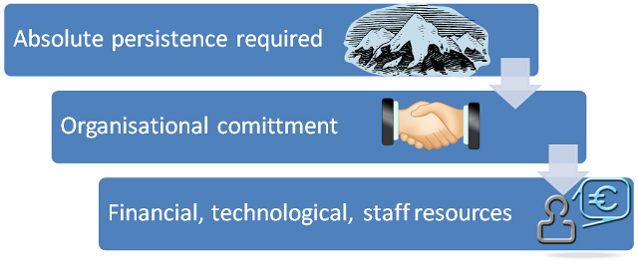PERSISTENT IDENTIFIERS:
COMMERCIAL AND HERITAGE VIEWS
1/9 – Identifiers in the commercial world
Summary
This learning object aims to give you a background knowledge of the systems commercial media companies use to keep track of their books, music, films and photographs as they imagine, create and sell them to the public.
It will point out some things that are similar to work done in the heritage sector, and introduce some new ideas from the commercial world.
Intended audience:
- library and information professionals & masters students
- heritage (museum, archive, gallery) professionals & masters students
Learning outcomes – readers should aim to:
- understand what persistent identifiers are used for in the commercial sector (and a little of what they are not for!)
How media companies handle information
A heritage organisation (a library, archive, gallery or museum) normally does as much of its activity “under one roof” as it can. It has many departments. Each specialises in one part of the “workflow” that gets a cultural object or work to the public.
In the modern commercial world, the story is very different. Of course, each media company has internal workflows. But it is very common that many different organisations each specialise in one aspect of the overall process that gets a product to its customer: the “supply chain”.
Below you can see a simple supply chain.
 1
1
Of course, this is simpler than real life. In real supply chains:
- Many organisations work at each stage, sometimes cooperating, sometimes competing, in a “web” of partners;
- One organisation can sometimes fulfil many or all of these roles;
- Many problems can be found at each stage.
To make sure the right information flows each way in the supply chain, as you can see in the diagram above, identifiers are used to make sure messages are understood correctly.
An order must identify unambiguously which goods are being ordered. An invoice must identify which goods the requested payment is for. Identifiers - simple and unambiguous labels for the goods in question - make this more efficient.
The key is to understand that the identifier 'enables' something - that is, the identifier has a role and purpose. In this case, the purpose is to enable efficient trading of information up and down a supply chain. Ultimately, it is the nature of the processes that the identifier enables which defines the nature of the identifier itself. So for example, the well-known ISBN identifies a book product, because it is book products that are traded in the book supply chain. It matters critically whether the book is a hardback or a paperback, and whether it is a second or a third edition, because the customer specifically wants the third edition in paperback. So different ISBNs are used for hardback and paperback, even though they have the same text content, and new editions get new ISBNs, even though they might both be paperbacks and have the same title. The nature of the ISBN - and the rules used to allocate new ISBNs - are guided by what the ISBN is used for, delivering the right product to the customer.
“Persistence” and why it matters
Now that museums and libraries present their collections on the World Wide Web, in a huge ocean of information, we are interested in using identifiers to help our “message” get through to the public, for example when creating “online exhibitions”, or “digital libraries”.
But the Web is a wild place and it takes time and effort to bring order to the chaos:
“[Identifiers] don't change: people change them.”2
In commercial terms, this is already a well known problem:
“Persistence is the consistent availability over time of useful information about a specified entity: ultimately guaranteed by social infrastructure (through policy) and assisted by technology”3
In the supply chain above, note that information has to flow in both directions. This information may be:
- part of the products, maybe printed on them, or “embedded” in a digital file, or
- accompanying them, as a separate document, such as an order or an invoice.
Reliable, up-to-date information is crucial, so that
- legal contracts will be kept,
- commercial decisions will be effective,
- predictions and plans can be made, and
- inefficiencies can be avoided.
This is where identifiers are useful – they provide a clear, fixed point to attach all the relevant information as it travels along.

Identifiers are links…
…against which you can compile and later discover or retrieve richer information about the thing which is being identified. An identifier links the order to the exact goods being ordered, or an invoice to the goods that the payment covers.
In a complex supply chain with many products and types of product:
- there may simply be too much information to handle at any one point
- the products themselves may change;
- and the information about a product may change.

Links in the information chain can be managed to keep the latest, correct information available.
A unique identifier can bring you to the exact thing that you are looking for…
…or to further information about it, but having just one piece of information about it cannot be guaranteed to achieve that. A unique ID is like a key that opens up further possibilities.

“Persistence” in the commercial sector means “forever”…
…with clear contingency plans in place to address any risks that it might not!
In the commercial sector, the meaning of persistence is normally understood as “permanence” – that is, persistent for ever. For example, in the case of the published book supply chain,
“an ISBN identifies a given title and its edition and binding for all time.”4
Maintaining a commitment like this has its costs:

Identifers for (e-)commerce are a kind of “infrastucture investment” and thus are often administered by
- public sector bodies, or
- non-profit organisations working for an entire industry sector.
In many cultural heritage contexts, and many other public-sector organisations, “persistence” is defined in relative terms – relative, for example, to the lifetime of a project that creates the product to be identified, or the existence of the organisation that identifies the object, or perhaps relative to the expected usefulness of the resources identified.
Identifiers only identify things…
…they do not give any other legal, commercial or technical guarantees.
Media producers, wholesalers and retailers use identifier numbers and codes for one very clear purpose: to manage information about the things being identified. This information management process can continue throughout - and beyond - the life of the thing that's being identified.
Often people think that since identifier numbers are created using a formal process, and are publically available, there must be some kind of legal meaning or commercial guarantee attached to the product. There is not!
Of course it is possible for a public sector or commercial body to attach its own meaning to the use of identifiers from “outside” the supply chain. The technical design of the identifier system may even make it more efficient. But that is not their main purpose.
Unique Identifiers: a brief introduction (PDF), by Brian Green and Mark Bide; 1999.
A short paper explaining the need for unique identifiers in the publishing business, discussing some of the basic issues raised in the Learning Object.






